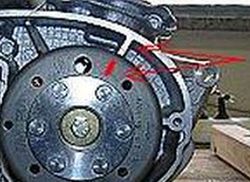Powerdynamo brings new ignition &
light
to your vintage motorcycle
|
Powerdynamo brings new ignition &
light |
|||||
| What and what for is a stroboscope and how do i use it | |
|
Wikipedia will tell us that a stroboscope: The timing light is connected to the ignition circuit (mostly inductively) and used to illuminate the timing marks with the engine running. The apparent position of the marks, frozen by the stroboscopic effect, indicates the current timing of the spark in relation to piston position. |
|
|
|
|
Those tools come in various shapes, most in gun- or torch shape. All need a power supply (230V or 12V) and they have a pickup unit (mostly a induction clamp to be put around the HT cable for impulse pickup) |
 |
|
|
|
For strobing the engine you set up the stroboscope (power
supply and HT clamp) and start the engine. The strobe will flash rapidly.
If it does not flash, turn the clamp by 180 degrees (that is side directed
before towards spark plug shall now be directed towards ignition
coil). You will notice still a flickering on the position of the strobed markings - and this is NOT some malfunction of the ignition. The strobe acts on both, start and end of spark. Sometimes it uses start, sometimes end to trigger the flash- it hence flickers. Additionally, when you try 3 different makes of strobe on the same engine you might get 3 different results. Strobes are not 100% accurate - but still the best you can get and better than static timing which in magneto systems is impossible anyway (save for following setting rules by trust) |
|
| In practical terms: | |
|
|
 |
|
|
|
| You obtain the needed ignition data from your motorcycle´s manual. As
a reference: 2 strokes from the 60s-80s would use about 27 degrees, that
is 2.5 to 3.5mm before top dead center (TDC is the highest point the
pistion can reach). Motorycyles from the 30s would use much more advance
(5-7mm). Old 4 strokes require more to 40 degrees as early setting and
about 2 or 8 for late. |
|
|---|---|
| Take spark plug(s) out. Find TDC (for 4 strokes the one in power stroke). Turn the crank (best by using the flywheel as a handle) back (check whether you have clockwise or anticlockwise turning flywheels!) until the piston has fallen to the needed value. | |
|
|
|
Sure, you will have to work precisely. Theoretically to 0,1mm or less accuracy. For this you use a gauge of some kind. As a makeshift device to get the thing running at all, use a pencil or screwdriver held into the plug opening to check piston position. |
 |
|
|
|
Now you will have to mark the flywheel with crank position in ignition position (2 strokes) or (4 strokes) early and late ignition against some stationary point on the engine. Some engine brace as here in the picture or a screw etc. Always make sure to do this with the crank resting in wanted ignition position. |

|
|
|
|
| Put the spark plug(s) back. Connect the strobe as per instructions
supplied with the tool and start the engine. The thing should start to flash rapidly. Should it not flash or flash only intermittently, take the clamp from the HT lead, reverse it (side that was before towards plug now facing towards ignition coil). |
|
|
|
|
|
|
|
|
|
| The following will depend on whether you have a 2 stroke, a 4 stroke, a clockwise turning or anticlockwise turning flywheel. Principle however is always same. | |
| Check whether the marking on the rotor is opposite the landmark on the
engine as it was in static position during setup. In the picture here (for a clockwise turning flywheel) alignment with the light green line indicated OK. Alignment more with the red line means spark is to late, well anyway later than wanted. Alignment more with the blue line means spark is to early, well anyway earlier than wanted. |
|
|
|
|
| If the markings do not align 100%, no panic. As mentioned stroboscopes
are not 100% accurate, you might be reading a little from the side and
most older engines are quite forgiving. If this is a consolation: the old manufacturer data are definitely no longer accurate either. They had been found using petrol often with quite low grade petrol (68-88 octane). Today we have 94 or so. Flame development is hence a lot faster and less advance is needed, but how much less only you can find out by experiment. |
Note on 4 strokes with access only to camshaft:
As the cam turns at half speed of the crank, also the angles of timing
change are halved. |
|
|
|
| Important is that the engine runs smoothly and has pulling power. IF
that is the case, stop fiddling with ignition. You only make it worse. Should you want to modify settings after your strobing experiences you do as follows: a) Make a note of how much (mm) and in what direction the marking you made on the flywheel appears shifted in the flash. b) Unless the base plate permits changes, you will have to pull the rotor (without modifying crank position) and reset it in a way that corrects the misalignment you did see during strobing. c) Fix rotor securely and strobe again. Hopefully now you have what you wanted, otherwise redo the exercise (batter in that case have a beer first) |
In 4 strokes, the markings shift with engine acceleration (due to automatic advance) The markings should change gradually from late to early mark. You can see a short video of this here |
| to Knowledgebase | |